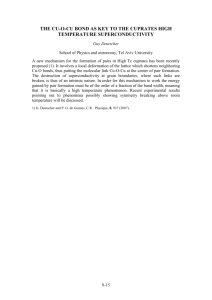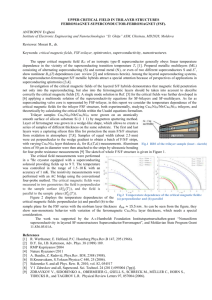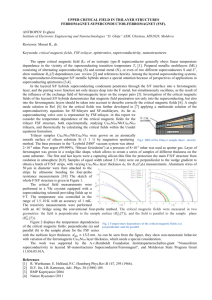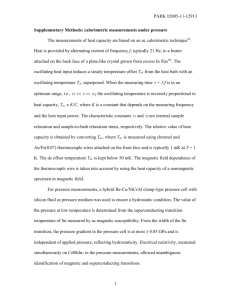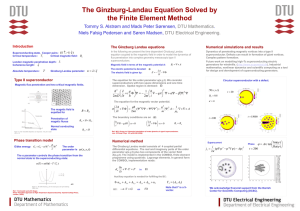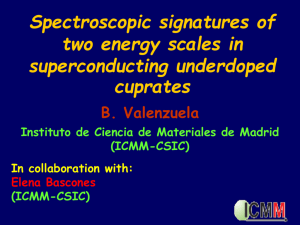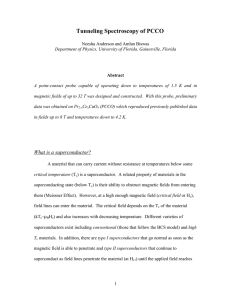Cuprates
advertisement
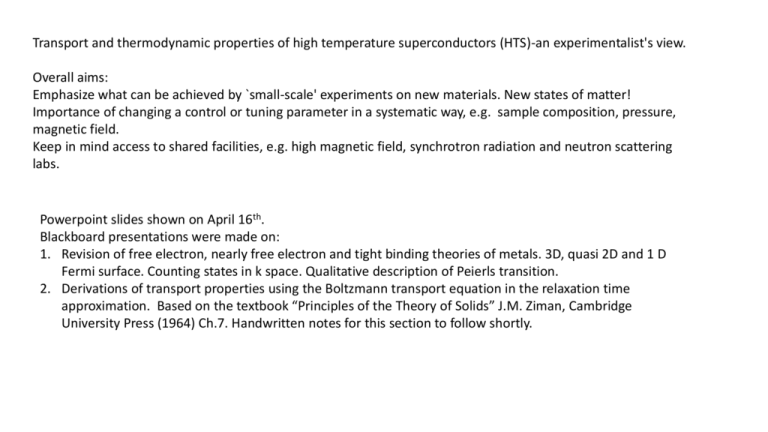
Transport and thermodynamic properties of high temperature superconductors (HTS)-an experimentalist's view. Overall aims: Emphasize what can be achieved by `small-scale' experiments on new materials. New states of matter! Importance of changing a control or tuning parameter in a systematic way, e.g. sample composition, pressure, magnetic field. Keep in mind access to shared facilities, e.g. high magnetic field, synchrotron radiation and neutron scattering labs. Powerpoint slides shown on April 16th. Blackboard presentations were made on: 1. Revision of free electron, nearly free electron and tight binding theories of metals. 3D, quasi 2D and 1 D Fermi surface. Counting states in k space. Qualitative description of Peierls transition. 2. Derivations of transport properties using the Boltzmann transport equation in the relaxation time approximation. Based on the textbook “Principles of the Theory of Solids” J.M. Ziman, Cambridge University Press (1964) Ch.7. Handwritten notes for this section to follow shortly. Overview of HTS subjects to be covered 1. Systematic patterns in normal state transport properties, resistivity, thermoelectric power, Hall effect as a function of hole doping and cation substitution 2. Thermodynamic properties, heat capacity and magnetic susceptibility/magnetisation in normal and s/c states. Especially for hole-doped cuprates. 3. High magnetic field studies at international facilities especially Quantum Oscillation (QO) work. But will try to make it relevant for students working on other problems / materials, e.g. by talking about experimental methods PLEASE INTERRUPT IF YOU THINK IT WILL BE HELPFUL! Periodic table of elements showing superconducting transition temperatures Courtesy of A. Carrington, University of Bristol, 2003 Superconducting elements and compounds Elements (see table), “less good” metals superconducting. Until quite recently superconductivity and magnetism thought to be incompatible. Tc(K) A15 compounds Nb3Sn 18.2 Nb3Ge 20.3 Organics (TMTSF)2PF6 1.2 k-(BEDT-TTF)2Cu(SCN)2 10.4 Cs3C60 33 Heavy Fermions CeCu2.2Si2 0.9 CePd2Si2 (under pressure) 0.4 UBe13 0.9 UPt3 0.45 Magnetic materials UGe2 (under pressure) 0.4 Nearly ferro-magnetic Sr2RuO4 1.3 Cuprates La2-xSrxCuO4 38 YBa2Cu3O7-d 93 HgBa2Ca2Cu3O8+d (under pressure) 130 (164) Borides HoNi2B2C 8 YNi2B2C 15 MgB2 39 Pnictides (P, As) Nd(O1-xFx)FeAs 52 Also late last year Eremets group H2S at extreme pressure 190 K! arXiv:1412.0460 H gO x ELECTRONIC PHASE DIAGRAM Temperature BaO Cu O 2 Ca Cu O 2 Ca Cu O 2 TN AF Mott insulator BaO Universal pseudogap energy H gO x Tc Glass H g Ba 2Ca 2 Cu 3O 8+x 0 2+ Tc = 134K - 160K d-wave Superconductivity 0.05 Cu correlated metal Pseudogap metal 0.16 2.05+ 2.16+ Cu Cu Extremely weak s/c Best 0.19 ~0.3 Holes /Cu 2.3+ Cu s/c scales with Tc Diagrams from Prof. W.Y. Liang Cuprates (Bednorz and Muller, 1986) Top view of CuO2 plane Crystal structure of highest Tc cuprate Typical Cu-O co-ordination in cuprate superconductors 6 p orbitals PF6- Jerome et al (1980) CePd2Si2 Julian et al (1999) Saxena et al. (2000) Cuprates (Bednorz and Muller, 1986) Parent compounds anti-ferromagnetic Mott insulators e.g. La2CuO4, Count electrons 2La3+ 6+, 4O2- 8-, Cu2+, so Cu (3d10 4s1) 3d9. one hole in d shell, one hole per unit cell, but not conducting. Correlated electrons, Mott-Hubbard insulator. Antiferromagnetic, Neel temperature 300 K. Dope lightly with holes, e.g. replace 8% of La3+ atoms with Sr2+ get 40 K superconductor! La2-xSrxCuO4 , 1+x holes per CuO2 unit. Now think that all hole doped cuprates show similar behaviour as function of number of added holes, p (p = x for LSCO). YBa2Cu3O6+x , add O2- , add holes to CuO2 layers until have YBa2Cu3O7 Layered compounds, wide range of anisotropy, CuO2 layers source of superconductivity 8 Two Bpopular theories: 1.The “t-J” model - starting from the Mott-Hubbard side. J S .S i j t + + Holes moving in an a-f background attract each other because minimise magnetic perturbation. Analytical theory difficult because double occupancy is excluded. Numerical calculations at high T account for many of the strange properties of the cuprates. See e.g. “Numerical studies of the t-J model”, J. Jaklic and P. Prelovsek, Adv. Phys. (2000), 1, 1-85 starting with “t-J” Hamiltonian: + Does give strong p dependences of electrical conductivity and entropy that are observed experimentally. Almost no adjustable parameters. Origin of PG? 9 2. The spin-fluctuation model or nearly anti-ferromagnetic Fermi liquid model, NAFL (Pines et al., Moriya et al.). Start from LDA Fermi surface containing 1+p holes per Cu. Introduce antiferromagnetic correlations in self-consistent way. Enhanced magnetic response at Q = (+/-p/a, +/-p/a), corresponds to proximity to a-f ordered state. Long-lived a-f spin excitations of wave-vector Q can be formed by correlated occupancy of k and (k+Q) states. These are spin fluctuations, collective excitations of Fermi liquid. Analogy : mixing of k and k+G states in nearly free electron theory of metals gives modulations in charge density with period of lattice parameter. Early (1993) model used by us to calculate Hall coefficient and thermoelectric power. lQ and lc are electron mfp’s in spanned and unspanned regions. x is range of a-f correlations, Similar picture works well for superfluid He3 (ferromagnetic fluctuations). Supported by NMR, neutron scattering and ARPES data, predicted d-wave pairing. Pairing given by virtual exchange of spin fluctuations. Are they strong enough to produce the high Tc s found in the cuprates? And strong p-dependences of conductivity and entropy? 10 Four terminal resistance measurements. R0 is resistance at 273.16 K. As increase purity of metal resistance ratio, R273.16/R4.2 increases. Controversy between Kelvin, Dewar and Matthiessen about R(T 0). Kamerlingh Onnes (Leiden 1911). Present limit for small s/c Pb ring with trapped field (Quinn and Ittner, J. Appl. Phys, 33,748, 1962) r < 3.6 10-23 cm (no decay in magnetic moment over a time of expt., so L/R > 7 hrs). Nowadays use s/c coils in persistent mode to provide high magnetic fields ( e.g. 18 T) without power dissipation. From G. Gruner Rev. Mod. Phys. 60, 1129 (1988) From P. Monceau et al. PRL, 37, 602 (1976) From G. Gruner Rev. Mod. Phys. 60, 1129 (1988) From D. Jerome and H.J. Schulz, Adv. Phy. 31, 299-490 (1982) From G. Gruner Rev. Mod. Phys. 60, 1129 (1988) Interacting Fermions in 1 D MgB2 Fermi Surface with dHvA orbits J. Kortus et al, PRL 86, 4656 (2001) From JRC, Handbook of Superconducting Materials, D.A. Cardwell and D.S. Ginley, Eds, IoP (2002) p. 1461 Another pair of contacts opposite Diagram from A. Carrington’s PhD thesis 1993. For crystal, thickness t = 20 microns, 0.2 mm between voltage contacts and 0.2 mm wide and ρa = 50 e-6 ohm-cms (OII YBCO just above Tc), Ra only 25 milliohms. One reason why people using pulsed magnetic fields often measure ρc . Resistance of contacts – 1 ohm considered good, therefore separate I and V contacts – 4 terminal method - essential RH = 1/ne, (n is carrier density). Estimate Hall voltage VH= RH I B/t Take RH = 2 e-9 m3/C , e.g. Carrington et al, Phys Rev B 48 13051, 1993, then for I = 1 ma, t = 20 microns and B = 10T get VH = 1e6 V. In practice need to see how large I can be without getting too much heating. Also check that voltage noise does not increase with I. If it does then no point in increasing I further. Stability of contacts important for measuring RH, e.g. Heat treated silver paint (Dupont 6838) often better than room temperature cured Dupont 4929. Sketch set up matching transformers. Twisted pairs especially high field. Johnson noise. From JRC, Handbook of Superconducting Materials, D.A. Cardwell and D.S. Ginley, Eds, IoP (2002) p. 1461 Thermoelectric power, thermopower, Seebeck coefficient (S) From JRC, Handbook of Superconducting Materials, D.A. Cardwell and D.S. Ginley, Eds, IoP (2002) p. 1461

